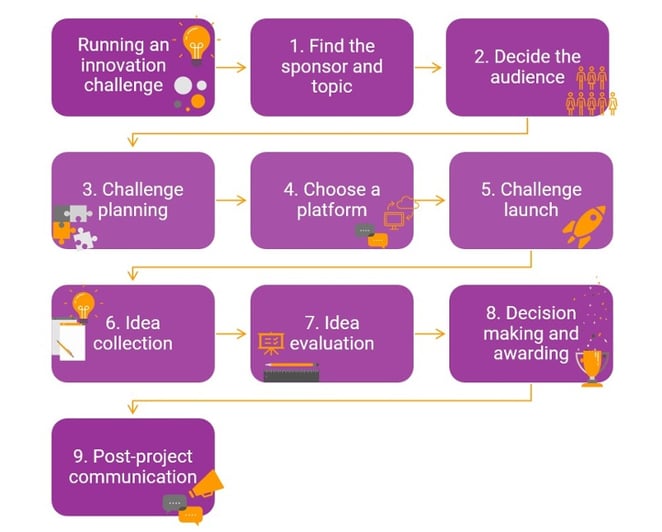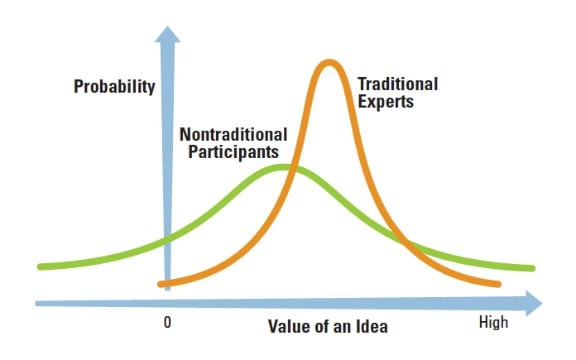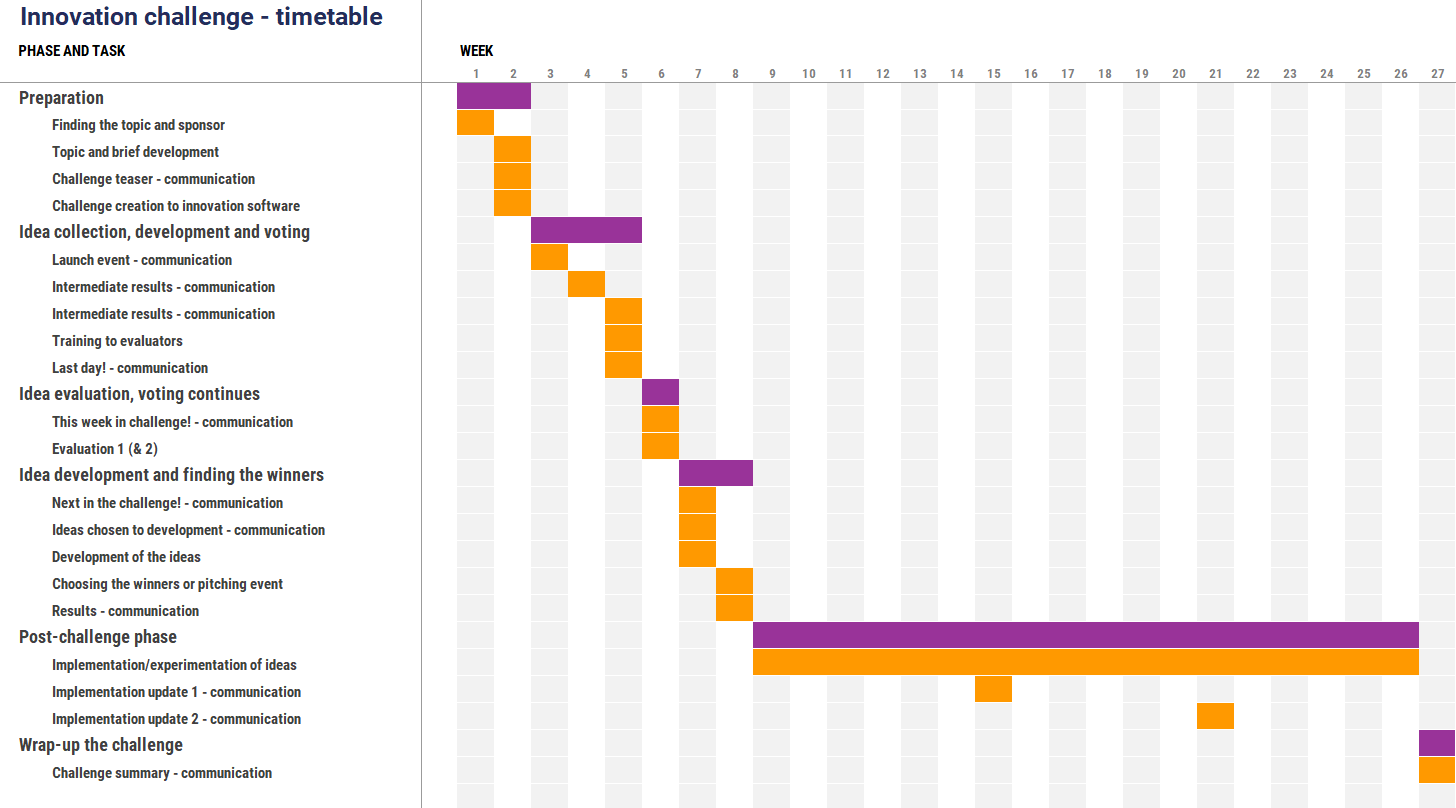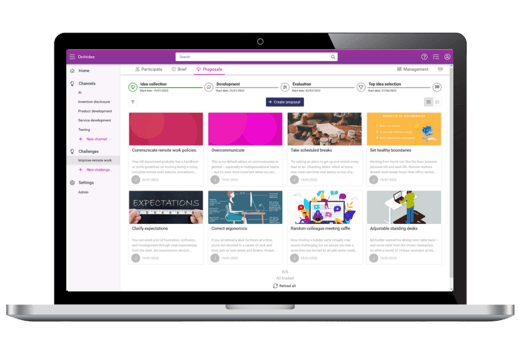What is an innovation challenge?
We define an innovation challenge as a time-limited idea-collection campaign that focuses on a specific topic. Depending on the chosen approach challenges can last from a couple of days to several months. The target audience varies from employees to partners and customers to a mixture of them. The topic of the competition is often chosen based on the strategic targets of the organization and the needs of the leaders. We at Orchidea have worked around the topic over the years with dozens of clients. Based on our experiences, we share our best practices on how to run an innovation challenge.
The steps of running an innovation challenge are:
- Find the sponsor and topic
- Decide the audience
- Plan the challenge
- Choose a platform
- Challenge launch
- Idea collection
- Idea processing and evaluation
- Decision-making and awarding
- Post-project communication

We’ll take a look at each step in more detail later in the article.
Why and when should you run an innovation challenge?
Innovation challenges provide a powerful way of generating ideas from your employees or customers while also providing access to fresh sources that would otherwise only be accessible through expensive methods like R&D projects or market research surveys.
Challenges have a significant role in the annual plan of innovation activities. According to Gartner's report, around 20-50% of organizations use challenges in their innovation activities. Their purpose is to generate new ideas in areas relevant to the organization's strategy and management needs. It is normal to have fluctuations in participation activity inside an organization. Including contests as a regular part of the annual plan keeps the innovation activity high.
Running an innovation challenge has several benefits:
- It complements continuous innovation and keeps innovation in people's minds
- It links innovation to strategy by providing solutions to topics that have strategic importance
- It deepens participants' understanding of the strategy when they work on the topic
- It increases the commitment of the management when they see proposals being developed for strategic objectives
- It is a quick tool to react to sudden changes in the business environment (see below...)
|
Case Example: From idea to new business in just three MonthsIn March 2020, the world was hit by the pandemic and organizations faced multiple challenges in their operations. Our customer that provides solutions to the building industry immediately started an innovation challenge in April to find ways to adapt to the changing landscape and serve their customers better in the new situation.
The challenge generated numerous excellent ideas on:
|
Innovation challenge steps: How to organize your competition?
Well begun is half done. That's why you need to pay extra focus on planning your innovation challenges. Let's take a closer look at the steps you need to take in order to organize a successful innovation challenge.
1. Find the sponsor and topic
The most crucial step in preparation is to find a sponsor with a topic that requires solutions. Running a challenge without funding or real need is dangerous because it increases the risk that the best proposals won't be implemented. This will decrease the willingness to participate in future challenges.
Once the sponsor is found, work on the topic with them. Forming a solid challenge question helps in achieving the goals.
The basic form of a challenge question is: How might we [verb] [desired result]?
Here are a few examples of well-designed innovation challenge questions:
- How might we decrease the fuel consumption of the motor by 50 %?
- How might we increase customer satisfaction by 50 %?
There are several techniques for developing challenge question alternatives. They are described in the article: Why innovation challenge design is important and how to do it.
The challenge question is accompanied by a brief that describes the expectations. The brief of the challenge should include:
- background about the sponsor and the challenge
- how the topic links to the strategy, objectives, and customers
- what is already known about the topic
- what types of solutions are desired: e.g., products, services, business models, processes
- are some types of suggestions undesired
- idea competition process: e.g., steps, timeline, feedback, rewarding
- how ideas are evaluated and what the criteria are
Communicating the evaluation criteria in advance helps the contributors in prioritizing and refining their proposals.
When you are arranging your first challenges, it's also essential to consider how the choice of the challenge may impact the cultural transformation of the organization and the relationships with its stakeholders. Often, it's very tempting to target the first competition at some ambitious problem that has been tried to solve for the last 10 years unsuccessfully. Unfortunately, the problem likely remains unsolved because it is a hard nut to crack.
When the participants are new to collaborative innovation, the competition should be such that
- It is relatively easy to participate
- the best ideas are easy and fast to implement
- the company needs the solutions and is therefore committed to implementing the best ideas
When the challenge is formed with these specifications in mind, it will drive positive cultural change when many stakeholders or internal employees participate. The change is emphasized when contributors see the best solutions implemented soon after the challenge ends.
2. Decide the audience
While the challenge question and the brief are developed, start thinking about the target audience. It is crucial to estimate their capability and motivation to solve the presented topic in advance. Think about your audience. What will motivate them? What will excite them? What are they interested in? If you can combine the interests of the audience with your goal, better results are guaranteed.
There are two types of innovation challenges: internal and external innovation challenge. Often it is advisable to start with an internal challenge with the company's own employees. There are several good reasons to do so:
- communication is simpler and faster
- it is easier to react to possible issues
When the organization has gained experience, it makes sense to start involving external audiences and run an open innovation challenge. External audiences are especially good at spotting opportunities outside the organization's experience base.
According to MIT Sloan Management review article, open innovation challenges often attract non-traditional contributors. On average these non-traditional innovators can't beat traditional experts. However, they are more likely to develop high-value solutions due to the creation of more diverse proposals.

Picture source: MIT Sloan Management Review - Spurring Innovation Through Competitions
3. Plan the challenge
Plan the timetable
The next thing you should do is to start planning the challenge and decide the timetable for the competition. How to do that depends on the participants, their knowledge of the topic, and the communication.
When the target audience
- has a strong motivation to participate,
- is familiar with the concept of the innovation challenge, and
- receives the related communication effectively,
the idea collection may be as short as a few days. An example of this could be running a challenge with an R&D department that has participated in tens of challenges before.
However, when
- the communication channels to the target audience are more unreliable
- participation is based on more personal decisions, and
- audience unfamiliar with the concept,
it is wise to dedicate 1 - 3 weeks to idea collection and preparing a solid communication plan.
The typical timetable and phases of a challenge with a 3-week long idea collection are presented in the picture below.

Set the objectives for the challenge
One crucial element in the plan is the objectives. You should keep the objectives in your mind during the whole challenge, from planning to wrap-up. What are you trying to achieve? Do you want to aim for the quantity or quality of submitted ideas or the number of implemented ones at the end of the competition?
The goal that has been set in advance and shared in the launch should be utilized in the ongoing communications. It is also important to define when the challenge has achieved its goals and how it is measured.
Plan the communication
What you should plan next, is communication. Regular communication includes activities both during the active phase and in the post-challenge phase. The communication should take place in channels that reach your target audience, e.g. Teams, Slack, email, social media, video, etc.
Communication during challenge
- Launch event or video
- Posters, flyers, or a stand in visible locations such as the lobbies, cafeteria, and conference rooms to advertise the challenge and encourage participation
- Attend meetings to give short briefs about the challenge and its goals
- Bi-weekly communication in appropriate channels
- Prize ceremony/pitching event/shark tank where winners are chosen/published
- Give more information and coaching to the competing teams if necessary
From our past experiences, we have found that having regular bi-weekly communication throughout the challenge increases the probability of success. Below is an example of the daily visitors -profile of a challenge, where two emails were sent each week. It is obvious that the activity has been sustained during the whole challenge with regular communication. Without weekly communication, the participation profile would be more U-shaped.

Ideas for innovation challenge communication topics:
- A new phase in the challenge
- Most popular ideas
- People behind the ideas
- Stories behind the ideas
- Exemples of participants
Post-challenge communication
- Monthly communication following implementation or experimentation of the winning ideas
- Wrapping up the results when most of the winning ideas are implemented
- Reminding about the origins of the new solutions that are launched based on the challenge
4. Choose the platform and tools
You should also think about the tools and the platform you will use in order to run the challenge. There are many different ways to do that. Without idea management software, you might need multiple tools and channels to keep communication working.
You should choose whether you're hosting your competition via email, intranet, dedicated idea management software, or another platform of your choice. However, using an eligible tool can save you a lot of time and effort, which you could put into running the innovation challenge itself.
💡 Read our article: How to choose your innovation challenge platform? - 7 tools compared
First, set up a company-wide communication tool like Teams, Slack, Intranet, or multi-channel solution e.g. email and announcements in the canteen, to get in touch with the participants.
Then, create a process for collecting and developing ideas. Collect the ideas for example via email or Slack or by setting up a submission form on your website. Then publish the ideas and let the participants develop them further by sending enhanced ideas via email or another chosen tool.
The last step is to set up a system for evaluation and voting. You can do that in a number of different ways. You can, for example, make a Google Form and ask your employees to vote on which ideas they think should be implemented. After that, you can go through the forms and evaluate them by using Excel, or Google Sheets.
 If you're looking for a simple solution for all these steps, use a tool like our innovation software Orchidea, where you can share, vote, and develop ideas together, and evaluate them transparently, all in one place. Orchidea has a specific challenge feature to use for free.
If you're looking for a simple solution for all these steps, use a tool like our innovation software Orchidea, where you can share, vote, and develop ideas together, and evaluate them transparently, all in one place. Orchidea has a specific challenge feature to use for free.
With Orchidea, you can select a pre-made template for your challenge and launch your contest within seconds.
5. Launch the challenge
The challenge is often launched at an event or with a video. The launch should be scheduled to coincide with a highly attended event like a quarterly meeting or similar.
The innovation challenge launch should focus on
- Motivating the contributors
- Briefing the topic and its link to objectives and strategy
- Communicating the incentives
- Presenting the idea assessment criteria
Keep the communication open and promote the challenge throughout the idea collection. That way, you ensure that the topic is still on people's minds and that enthusiasm lasts after the launch.
|
Case Example: Fostering collaboration and launching an innovation program with a challengeOur customer in the media industry wanted to encourage their employees to think creatively and come up with new ideas for the company. To do this, they launched new innovation program. To get a kick-start to the program, the launch happened via an innovation challenge.
The company ordered four-piece puzzles and distributed one piece to each employee on the morning of the challenge launch. Each employee was then tasked with finding three other employees who had the other pieces of the puzzle and completing the puzzle. Once they had found their group and completed the puzzle they would receive refreshments and cake from the cafeteria. The purpose of this was to create a relaxed atmosphere where employees could enjoy the refreshments while discussing ideas. After the discussion, each group submitted their best idea to the challenge. Overall, the innovation challenge was a success, with many employees coming up with new and innovative ideas. The puzzle highlighted the importance of teamwork and collaboration in driving innovation and growth within the company. |
6. Idea collection
After the launch, it's time to start gathering ideas. Start by telling the audience via multiple channels that you want to hear their thoughts. You can do this by sending out an email to the target audience and publishing a note on the intranet.
Use the chosen tools to collect ideas and make sure everyone has access to them. Also, make sure that there are ideas submitted within the first hours of the challenge to avoid white page syndrome! For example: get a few key players to help and submit ideas, or organize a brainstorming workshop to kick-start the challenge and add the developed solutions to the challenge.
For communication, a good practice is to communicate the progress to the whole target group weekly. Using multiple channels that are working on your organization, like Teams, email, and Slack, ensures that people get the information.
Use activating phrases in your communication, such as "Most discussed ideas" "Most viewed ideas," and so on. Also, urge everyone to share information about the challenge and their thoughts with others so that it stays in people's minds.
Give a chance to comment and vote for others' ideas. The participants get more engaged with the process when they can influence it. The evaluators also learn valuable information on what the crowd considers vital, and the concepts get further developed. If you are using a platform, where discussion is possible, also make sure that you show examples of being active. Comment and develop others' ideas, recruit people to join the discussion, or active people by asking experts to share their knowledge.
Once the idea-collection phase is about to end, send a reminder. That way you ensure that all generated proposals are collected.
|
Case Example: Leveraging leadership team involvement to drive challenge participation
An industrial company recently launched a new strategy and sought to collect fresh product ideas that would support it. To achieve this goal, the company organized a challenge, with the CEO serving as its sponsor.
The challenge team asked the assistants to book 15-minute appointments on all the leadership team members' calendars. During these appointments, they would visit the challenge platform and comment on the ideas that interested them.
The coordinated leadership team participation turned out to be a huge success, triggering a surge in challenge participation to new levels. The involvement also served as a positive example for the rest of the company, encouraging more employees to participate and contribute their ideas. The leadership team's participation highlighted the importance of involving key stakeholders in the ideation process and showed the power of showing engagement with the ideas.
|
7. Idea processing and evaluation
Once the idea-collection is over, it's time to process and evaluate the ideas that were submitted. Processing and evaluation should be systematic. The idea management software here can help you in systematizing the evaluation and management.
Many companies worry about getting overwhelmed reviewing ideas. It can be burdensome to process all the ideas in the same way. A better method is to use the innovation funnel. It consists of a series of stages, each with a decreasing number of ideas, as the ideas are progressively screened and refined until the most promising ones are selected for further development. In the early stages of the funnel, you typically spend only a few minutes per idea to review them and then move on to the next one. As you progress through the funnel and start to narrow down the list of ideas, you will typically invest more time in each idea to evaluate its potential and develop it further.

When defining the evaluation process, it is important to decide:
- how many assessment phases there will be and who will conduct them
- whether the ideas that pass the evaluation will be further developed before the finalists are chosen; we strongly recommend this because it increases the quality of the results
- how the finalists will ultimately be decided.
The management and experts make the final decision on which ideas to implement, as they have the best overall picture of both the benefits and investments required. However, when selecting the finalists, it is advisable to take into consideration also the votes of the crowd.
Example of challenge evaluation stages:
- 3 experts evaluate all ideas by answering the question: would you implement this idea? (With the response options: yes / maybe / no). The top 15 % of the ideas are moved to the next stage.
- 3 experts evaluate each idea in 3-4 criteria on a scale of 1-5 (needs improvement - excellent).
The main objective of the evaluation is to understand if proposals address customer needs, are feasible, and are financially sound. Therefore evaluation criteria often include
- Innovativeness criteria like novelty, creativity, feasibility, scalability, customer value
- Financial metrics like estimated implementation cost, revenue, margin, ROI
After the numerical evaluation, the experts should meet and discuss the best 10 - 20 best ideas based on numerical evaluation averages. They should discuss whether there are any surprises among those ideas, and if ideas should be added or removed from the group. This ensures that the decisions made in the evaluation are validated and that the best ideas are taken forward. Experts should also give ideators feedback for further development so that ideas are their best when they arrive at final decision-making.
Note that even though you'd have chosen to award only a certain number of ideas, you should implement all worthy ideas. It will increase the motivation of all stakeholders to participate and organize innovation challenges again.
8. Decision-making and awarding
Decision making
After the ideas are evaluated, it's time to make the final decisions about the ideas to be awarded and implemented.
Note: further developing ideas before deciding on a winner is worthy since ideas are rarely completely ready at first.
Options for decision-making:
- Decision-makers e.g., the management team reviews further developed ideas before the meeting. At the meeting, the topic is discussed and the ideas to be rewarded and implemented are decided.
- An expert involved in the evaluation process presents the ideas that have reached the final round to the business manager. Based on the presentation, the business manager decides on the ideas to be rewarded and implemented
- The ideas that have reached the final round are presented/pitched to the management team in a lion's den-type session. The idea implementers have prepared, if necessary, for this session the investments needed for the next stage of the idea implementation. Based on the presentations, the management team decides on which ideas they will invest their money in.
Awarding
The key thing to successful innovation activities is the intrinsic motivation to participate. Still, external motivators matter.
The innovation challenge ends with a prize ceremony where the winning ideas and solutions are chosen. How to plan the best reward for those who win? In general, there is not just one solution that would work well under all circumstances: it always depends on the innovation competition and the target audience.
It is important to remember that the rewards are not just the prize money - they represent the value of participating in the open innovation challenge process which will be recognized more and more often by the business world.

Examples of the rewards:
- Winners will become members of the idea implementation project
- Winners will receive an affordable cash prize at the closing ceremony and will be featured in the intranet and the customer magazine
- Winners will be invited to a training course or seminar trip according to their own development plan
9. Post-project communication
You shouldn't stop when the actual competition has finished. Post-project communication is an essential element of the innovation challenge process.
In this step, you need to communicate that the innovation challenge is over and how to get in touch with your organization in case of questions. You should thank the teams for participating and let them know what they will get from it.
Also, include any other important information like how to view the results. It is a good idea to post the winners on your blog so everyone can know who they are!
Share information on the implementation and the status of the ideas. Also, let them know about the gained benefits and new courses of action adopted based on the challenge.
A good practice is to inform 2-3 times in the 6 months after the challenge about the state of implementation.
For future innovation competitions, collect and provide feedback to improve activities. One feedback method to use is the NPS. Remember to keep the survey short to get a good response rate.
Ideas and tips for innovation challenge
- Consider the IPR perspective and define the terms and conditions for the challenge in advance
- Scale – more participants. To succeed, an innovation program needs lots of contestants. It's the wisdom of the crowd: a large mass will always out-ideate a small team of smart people.
- Diversity – more kinds of people contributing. You might think the best innovation system would be full of engineers or other problem-solvers. You'd be wrong. A successful system needs contributions from all over the organization, especially staff who are close to the front lines: sales staff, support workers, or people in close touch with the company's manufacturing processes, for instance.
- Show a good and badly formulated idea so staff knows what 'good' looks like
- Offer a skill-building event to equip staff with brainstorming techniques
- Run workshops in team meetings
- Make sure that the first ideas are already submitted to avoid blank page syndrome
- Disclosure Risk: In describing the challenge you seek to address, you are sharing important information with the world
- The challenge teams show an example
Popular innovation challenges
Numerous innovation competitions are held all around the world, both in startups and larger businesses. There is a constant stream of innovation-related contests that take place in cities worldwide, and reward inventors with prize money, recognition, and publicity for their work.
Innovation challenges have become one of the most essential tools for promoting start-up companies and bringing innovative ideas to life. The topics of innovation goals may range from technology to services, as well as engineering and the creation of new business models, depending on the industry.
Netflix
Netflix is a great illustration of the open innovation competition. They challenged the crowd to develop its movie recommendation algorithm. They promised a 1 million USD grand prize for the solution that would improve it by 10 %. Between 2006 and 2009, they received over 44 000 entries. The diversity of submissions was visible in the results of entries submitted during the first 33 weeks:
- 2/3 of entries performed worse than Netflix's own algorithm
- The top 90 entries were better by 5 % and the best by 7 %
In 2009, almost 3 years after the launch of the competition, the winning solution was submitted.
NASA
In 2005, NASA began adopting open innovation as a mechanism for fostering creativity and innovation. Prize competitions and crowdsourcing are utilized by their operations.
For instance, Green Flight Challenge called for teams to design a super-fuel-efficient full-scale aircraft capable of flying 200 miles in less than two hours. The winning team was awarded $1.3 million for their design.
The project showed that new ways to use green flight technologies could be found. It was a proof of concept for NASA to demonstrate that innovative uses for green flight technology can be discovered.
Lego
Lego has a site called Lego Ideas where more than 20 000 ideas are generated from the fanbase. Besides the written description, an image or a prototype must be submitted. The idea must get 10 000 supporters to get evaluated.
In Lego, they evaluate the idea by the profile of the supporters. By combining that with market research, they evaluate the potential of the idea.
If the idea is decided to be implemented, Lego pays 1 % of its revenue to the inventor. In addition, the inventor will receive 10 copies of the product and will be featured on the product packaging as the designer.
L’Oréal Brandstorm
L'Oréal uses idea contests to develop innovation projects with young entrepreneurs, students, and recent graduates. The Brandstorm is an annual innovation competition open to students and young professionals from around the world to find creative solutions to business challenges with the help of coaching and mentoring.
In 2021, the winning team got to put their plan into action for a three-month internship at the World’s Largest Startup Campus, Station F, in Paris.
💡For more innovation challenge examples, read our blog post: 6 Innovation Challenge Examples to Drive Creativity
Checklist for running an innovation challenge
By now, you know the steps of running successful innovation challenges. Follow these steps and remember all the details on the way:
- Find a sponsor or partner and a focused topic or problem to be addressed through the challenge
- Select and define a clear challenge question and brief
- Decide the audience: Include various people and motivate them to participate
- Define the evaluation criteria (such as feasibility, impact, and scalability)
- Choose a platform: Find the right tools to make your process seamless
- Schedule bi-weekly communications highlighting topics such as new phases, popular ideas, participants and their stories, and noteworthy contributions
- Idea collection: Make sure that everyone has enough time to get creative and participate
- Develop ideas further and be active: show example in the discussion and development
- Evaluate the submissions numerically against the predefined criteria
- Announce the winners and award them with prizes, funding, or other incentives
- Implement all worthy solutions! Share the outcomes of the challenge and communicate about the next steps
- Communicate about the results, collect and provide feedback
Get a complete checklist and timeline to ensure the successful launch of your innovation challenge from the link below!
How Orchidea could help
With Orchidea, you can create successful and efficient innovation challenges without any hassle. From launching a challenge and managing ideas to evaluating them, our platform ensures that the whole process is streamlined. It provides an integrated environment that makes it easier to collaborate across different teams and stakeholders. Plus, our analytics and reporting allow you to track the progress of your challenge, analyze the data and get insights on how to improve it. So, why not give Orchidea a try today? We guarantee that this will be an invaluable tool in your innovation journey!
- The built-in process guides you through the steps of the innovation challenge
- Manage the innovation challenge process in one place
- Transparent process: Everyone can see others' ideas, votes, and comments
Conclusion
An innovation challenge is a great way to foster creativity and an environment of innovation in your company. It can help you address specific challenges that you are facing.
They help create a space for innovation in your company and provide ideas in relevant areas to the needs of strategy and management. They provide a fresh perspective on what could be done better. They also bring people together from different departments to create a common pool that can be used by everyone afterward.
To run the most successful innovation challenge, you need to do some preparation. You’ll need to take care of the details and put together a plan, and delegate tasks and responsibilities. Once you’ve made it through the preparation phase, you’ll be ready to run an innovation challenge.
Hopefully, our expertise helps you to organize successful innovation challenges. If you have more tips for success, please share them in the comments below!







.jpg)

